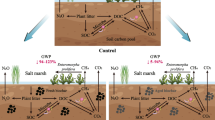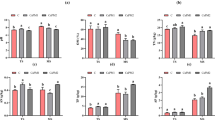Abstract
The energy metabolism structure of microbial community plays an important role in the process of biohydrometallurgy. In this article, an artificial microbial community composed of three strains (Acidithiobacillus ferrooxidans, Leptospirillum ferriphilum and Acidithiobacillus thiooxidans) was used to leach three kinds of chalcopyrites with different iron-sulfur ratios. After 36 d of leaching, the chalcopyrite with iron-sulfur ratio of about 1:1 achieved the highest copper extraction (69.62%). In the early stage, iron oxidizing bacteria predominated, and the expression of rus and rio was 8 times higher than that in the late stage. In the late stage, sulfur oxidizing bacteria predominated, and the expression of tetH and HdrAB was 4 times higher than that in the early stage. Furthermore, the three bioleaching systems above were added with elemental sulfur (3 g/L); the chalcopyrite with iron-sulfur ratio of about 2:1 achieved the highest copper extraction (80.63%). The results suggest that the energy metabolism structure of the microbial community could be changed by changing the iron-sulfur ratio during the leaching process for improving the leaching efficiency of chalcopyrite.
摘要
微生物群落的能量代谢结构在生物湿法冶金过程中起着重要作用。本文采用由嗜酸氧化亚铁硫杆菌、嗜铁钩端螺旋菌和嗜酸氧化硫硫杆菌三种菌株组成的人工微生物群落对三种不同铁硫比的黄铜矿进行浸出。经过 36 d 的浸出,铁硫比约为 1:1的黄铜矿的铜浸出率最高 (69.62%)。前期以铁氧化菌为主,rus 和 rio 的表达量比后期高 8 倍。后期以硫氧化菌为主,tetH 和 HdrAB 的表达量比前期高4 倍。此外,上述三个生物浸出系统添加元素硫 (3 g/L),且铁硫比约为 2:1 的黄铜矿的铜浸出率最高(80.63%)。结果表明,在浸出过程中改变铁硫比可以改变微生物群落的能量代谢结构,从而提高黄铜矿的浸出效率。
Similar content being viewed by others
References
DRUSCHEL G K, BAKER B J, GIHRING T M, BANFIELD J F. Acid mine drainage biogeochemistry at iron mountain, California [J]. Geochemical Transactions, 2004, 5(2): 13–32. DOI: https://doi.org/10.1186/1467-4866-5-13.
YOON Y J, LEE J E, BANG S J, BAEK Y D, KIM Y. Behaviors of trace elements caused by the precipitation of minerals in acid mine drainage [J]. Journal of the Mineralogical Society of Korea, 2018, 31(3): 173–182. DOI: https://doi.org/10.9727/jmsk.2018.31.3.173.
DENEF V J, MUELLER R S, BANFIELD J F. AMD biofilms: Using model communities to study microbial evolution and ecological complexity in nature [J]. ISME Journal Multidisciplinary Journal of Microbial Ecology, 2010, 4(5): 599–610. DOI: https://doi.org/10.1038/ismej.2009.158.
BAKER-AUSTIN C, DOPSON M. Life in acid: pH homeostasis in acidophiles [J]. Trends in Microbiology, 2007, 15(4): 165–71. DOI: https://doi.org/10.1016/j.tim.2007.02.005.
RAWLINGS D E, D BARRIE J. The microbiology of biomining: Development and optimization of mineral-oxidizing microbial consortia [J]. Microbiology, 2007, 153(2): 315–324. DOI: https://doi.org/10.1099/mic.0.2006/001206-0.
CELIA M, ANA I P, VICTORIA M, JESUS S, OLGA V G, MANUEL F. Microbial diversity and metabolic networks in acid mine drainage habitats [J]. Front Microbiol, 2015, 6: 475. DOI: https://doi.org/10.3389/fmicb.2015.00475.
CHEN L X, HUANG L N, MÉNDEZ-GARCÍA C, KUANG J L, HUA Z S, LIU J, SHU W S. Microbial communities, processes and functions in acid mine drainage ecosystems [J]. Curr Opin Biotechnol, 2016, 38: 150–158. DOI: https://doi.org/10.1016/j.copbio.2016.01.013.
HUANG L N, KUANG J L, SHU W S. Microbial ecology and evolution in the acid mine drainage model system [J]. Trends in Microbiology, 2016, 24(7): 581–593. DOI: https://doi.org/10.1016/j.tim.2016.03.004.
HAO X D, LIANG Y L, YIN H Q, LIU H W, ZENG W M, LIU X D. Thin-layer heap bioleaching of copper flotation tailings containing high levels of fine grains and microbial community succession analysis [J]. International Journal of Minerals, Metallurgy, and Materials, 2017, 24(4): 360–368. DOI: https://doi.org/10.1007/s12613-017-1415-4.
MA L, WANG X, LIU X, WANG S, WANG H. Intensified bioleaching of chalcopyrite by communities with enriched ferrous or sulfur oxidizers [J]. Bioresource Technology, 2018, 268: 415–423. DOI: https://doi.org/10.1016/j.biortech.2018.08.019.
LIU J, HUA Z S, CHEN L X, KUANG J L, LI S J, SHU W S, HUANG L N. Correlating microbial diversity patterns with geochemistry in an extreme and heterogeneous environment of mine tailings [J]. Appl Environ Microbiol, 2014, 80(12): 3677–3686. DOI: https://doi.org/10.1128/AEM.00294-14.
HUA Z S, HAN Y J, CHEN L X, LIU J, HU M, LI S J, KUANG J L, CHAIN P S, HUANG L N, SHU W S. Ecological roles of dominant and rare prokaryotes in acid mine drainage revealed by metagenomics and metatranscriptomics [J]. The ISME Journal, 2015, 9(6): 1280–1294. DOI: https://doi.org/10.1038/ismej.2014.212.
KUANG J, HUANG L, HE Z, CHEN L, HUA Z, JIA P, LI S, LIU J, LI J, ZHOU J, SHU W. Predicting taxonomic and functional structure of microbial communities in acid mine drainage [J]. The ISME Journal, 2016, 10(6): 1527–1539. DOI: https://doi.org/10.1038/ismej.2015.201.
KUANG J, HUANG L, CHEN L, HUA Z, LI S, HU M, LI J, SHU W. Contemporary environmental variation determines microbial diversity patterns in acid mine drainage [J]. The ISME Journal, 2013, 7(5): 1038–1050. DOI: https://doi.org/10.1038/ismej.2012.139.
MA L, WANG X, FENG X, LIANG Y, XIAO Y, HAO X, YIN H, LIU H, LIU X. Co-culture microorganisms with different initial proportions reveal the mechanism of chalcopyrite bioleaching coupling with microbial community succession [J]. Bioresource Technology, 2017, 223: 121–130. DOI: https://doi.org/10.1016/j.biortech.2016.10.056.
KAKSONEN A H, BOXALL N J, GUMULYA Y, NAHREEN K H, CHRISTINA M, TSING B, CHENG K Y, KAYLEY U, AINO-MAIJA L. Recent progress in biohydrometallurgy and microbial characterisation [J]. Hydrometallurgy, 2018, 180: 7–25. DOI: https://doi.org/10.1016/j.hydromet.2018.06.018.
WANG Y, CHEN X, ZHOU H. Disentangling effects of temperature on microbial community and copper extraction in column bioleaching of low grade copper sulfide [J]. Bioresource Technology, 2018, 268: 480–487. DOI: https://doi.org/10.1016/j.biortech.2018.08.031.
YIN S, WANG L, EUGIE K, XUN C, YAN R, AN K, ZHANG L, WU A. Copper bioleaching in China: Review and prospect [J]. Minerals, 2018, 8(2): 32. DOI: https://doi.org/10.3390/min8020032.
HALLBERG K, COUPLAND K, S, JOHNSON D. Macroscopic streamer growths in acidic, metal-rich mine waters in north wales consist of novel and remarkably simple bacterial communities [J]. Applied & Environmental Microbiology, 2006, 72(3): 2022–2030. DOI: https://doi.org/10.1128/aem.72.3.2022-2030.2006.
JOHNSON D B, ROLFE S, HALLBERG K B, IVERSEN E. Isolation and phylogenetic characterization of acidophilic microorganisms indigenous to acidic drainage waters at an abandoned Norwegian copper mine [J]. Environmental Microbiology, 2010, 3(10): 630–637. DOI: https://doi.org/10.1046/j.1462-2920.2001.00234.x.
WILLIAMS K P, KELLY D P. Proposal for a new class within the phylum Proteobacteria, Acidithiobacillia classis nov., with the type order Acidithiobacillales, and emended description of the class Gammaproteobacteria [J]. Int J Syst Evol Microbiol, 2013, 63(9): 2901–2906. DOI: https://doi.org/10.1099/ijs.0.049270-0.
FALAGÃ N C, JOHNSON D B. Acidithiobacillus ferriphilus sp. nov., a facultatively anaerobic iron- and sulfur-metabolizing extreme acidophile [J]. Int J Syst Evol Microbiol, 2016, 66(1): 206–211. DOI: https://doi.org/10.1099/ijsem.0.000698.
SABRINA H, D BARRIE J. Acidithiobacillus ferridurans sp. nov., an acidophilic iron-, sulfur- and hydrogen-metabolizing chemolithotrophic gammaproteobacterium [J]. Int J Syst Evol Microbiol, 2013, 63(11): 4018–4025. DOI: https://doi.org/10.1099/ijs.0.049759-0.
GOLTSMAN D S A, MAUNA D, THOMAS B C, SHAH M B, VERBERKMOES N C, HETTICH R L, BANFIELD J F. New group in the Leptospirillum clade: cultivation-independent community genomics, proteomics, and transcriptomics of the new species “Leptospirillum group IV UBA BS” [J]. Applied & Environmental Microbiology, 2013, 79(17): 5384–5393. DOI: https://doi.org/10.1128/aem.00202-13.
ZHANG X, LIU X, YANG F, LV C. Pan-genome analysis links the hereditary variation of Leptospirillum ferriphilum with its evolutionary adaptation [J]. Frontiers in Microbiology, 2018, 9: 577. DOI: https://doi.org/10.3389/fmicb.2018.00577.
BACELAR-NICOLAU P, JOHNSON D B. Leaching of pyrite by acidophilic heterotrophic iron-oxidizing bacteria in pure and mixed cultures [J]. Applied & Environmental Microbiology, 1999, 65(2): 585–590. DOI: https://doi.org/10.1089/oli.1.1999.9.105.
FENG S, YANG H, WANG W. Improved chalcopyrite bioleaching by Acidithiobacillus sp. via direct step-wise regulation of microbial community structure [J]. Bioresource technology, 2015, 192: 75–82. DOI: https://doi.org/10.1016/j.biortech.2015.05.055.
HE J, CAI Z, ZHANG Y, XUE N, ZHENG Q. Effects of energy source on bioleaching of vanadium-bearing shale by Acidithiobacillus ferrooxidans [J]. Biochemical Engineering Journal, 2019, 151: 107355. DOI: https://doi.org/10.1016/j.bej.2019.107355.
ZHANG X, LIU X, LIANG Y, FAN F, ZHANG X, YIN H. Metabolic diversity and adaptive mechanisms of iron- and/or sulfur-oxidizing autotrophic acidophiles in extremely acidic environments [J]. Environ Microbiol Rep, 2016, 8(5): 738–751. DOI: https://doi.org/10.1111/1758-2229.12435.
ZHAN Y, YANG M, ZHANG S, ZHAO D, DUAN J, WANG W, YAN L. Iron and sulfur oxidation pathways of Acidithiobacillus ferrooxidans [J]. World Journal of Microbiology and Biotechnology, 2019, 35(4): 60. DOI: https://doi.org/10.1007/s11274-019-2632-y.
AMOURIC A, BROCHIERARMANET C, JOHNSON D B, BONNEFOY V, HALLBERG K B. Phylogenetic and genetic variation among Fe(II)-oxidizing acidithiobacilli supports the view that these comprise multiple species with different ferrous iron oxidation pathways [J]. Microbiology, 2011, 157(1): 111–122. DOI: https://doi.org/10.1099/mic.0.044537-0.
ZHANG X, YIN H Q, LIANG Y L, QIU Q Z, LIU X D. Theoretical model of the structure and the reaction mechanisms of sulfur oxygenase reductase in Acidithiobacillus thiooxidans [J]. Advanced Materials Research, 2015, 1130: 67–70. DOI: https://doi.org/10.4028/www.scientific.net/AMR.1130.67.
MANGOLD S, VALDÉS J, HOLMES D S, DOPSON M. Sulfur metabolism in the extreme acidophile Acidithiobacillus Caldus [J]. Frontiers in Microbiology, 2011, 2(1): 17. DOI: https://doi.org/10.3389/fmicb.2011.00017.
BONNEFOY V, HOLMES D S. Genomic insights into microbial iron oxidation and iron uptake strategies in extremely acidic environments [J]. Environmental Microbiology, 2012, 14(7): 1597–1611. DOI: https://doi.org/10.1111/j.1462-2920.2011.02626.x.
YIN Z, FENG S, TONG Y, YANG H. Adaptive mechanism of Acidithiobacillus thiooxidans CCTCC M 2012104 under stress during bioleaching of low-grade chalcopyrite based on physiological and comparative transcriptomic analysis [J]. Journal of Industrial Microbiology & Biotechnology, 2019, 46(12): 1643–1656. DOI: https://doi.org/10.1007/s10295-019-02224-z.
TALLA E, HEDRICH S, MANGENOT S, JI B, JOHNSON D B, BARBE V, BONNEFOY V. Insights into the pathways of iron- and sulfur-oxidation, and biofilm formation from the chemolithotrophic acidophile Acidithiobacillus ferrivorans CF27 [J]. Research in Microbiology, 2014, 165(9): 753–760. DOI: https://doi.org/10.1016/j.resmic.2014.08.002.
MEI K, NOGAMI S, KANAO T, TAKADA J, KAMIMURA K. Tetrathionate-forming thiosulfate dehydrogenase from the acidophilic, chemolithoautotrophic bacterium Acidithiobacillus ferrooxidans [J]. Applied & Environmental Microbiology, 2013, 79(1): 113–120. DOI: https://doi.org/10.1128/AEM.02251-12.
EDWARD C J, KOTSIOPOULOS A, HARRISON S T L. Low-level thiocyanate concentrations impact on iron oxidation activity and growth of Leptospirillum ferriphilum through inhibition and adaptation [J]. Research in microbiology, 2018, 169(10): 576–781. DOI: https://doi.org/10.1016/j.resmic.2018.10.003.
KHACHATRYAN A C. Influence of Fe2+ and Fe3+ on the growth of Leptospirillum ferriphilum CC and oxidation of Fe2+ [J]. Biological Journal of Armenia, 2019, 71(3): 83–88.
CORTES M P, ACUA V, TRAVISANY D, SIEGEL A, LATORRE M. Integration of biological networks for Acidithiobacillus thiooxidans describes a modular gene regulatory organization of bioleaching pathways [J]. Frontiers in Molecular Biosciences, 2020, 6: 155. DOI: https://doi.org/10.3389/fmolb.2019.00155.
ZHANG X, LIU Z, WEI G, FEI Y, LIU X. In silico genome-wide analysis reveals the potential links between core genome of Acidithiobacillus thiooxidans and its autotrophic lifestyle [J]. Frontiers in Microbiology, 2018, 9 1255. DOI: https://doi.org/10.3389/fmicb.2018.01255.
MÉNDEZ-TOVAR M, GARCÍA-MEZA J V, GONZÁLEZ I. Electrochemical monitoring of Acidithiobacillus thiooxidans biofilm formation on graphite surface with elemental sulfur [J]. Bioelectrochemistry, 2019, 128: 30–38. DOI: https://doi.org/10.1016/j.bioelechem.2019.03.004.
LIU H, LU X, ZHANG L, XIANG W, ZHU X, LI J, WANG X, LU J, WANG R. Collaborative effects of Acidithiobacillus ferrooxidans and ferrous ions on the oxidation of chalcopyrite [J]. Chemical Geology, 2018, 493: 109–120. DOI: https://doi.org/10.1016/j.chemgeo.2018.05.032.
Funding
Project(2017zzts382) supported by Central South University Postgraduate Independent Exploration and Innovation, China; Project(2014jpkc003) supported by Central South University Graduate Excellent Course, China; Project(2015JJ2165) supported by Hunan Provincial Natural Science Foundation of China; Project (165611031) supported by Central South University Fundamental Research Funds Special Funding, China
Author information
Authors and Affiliations
Corresponding author
Rights and permissions
About this article
Cite this article
Yang, Y., Zhu, Zy., Hu, Tt. et al. Variation in energy metabolism structure of microbial community during bioleaching chalcopyrites with different iron-sulfur ratios. J. Cent. South Univ. 28, 2022–2036 (2021). https://doi.org/10.1007/s11771-021-4750-6
Received:
Accepted:
Published:
Issue Date:
DOI: https://doi.org/10.1007/s11771-021-4750-6




